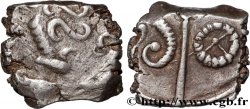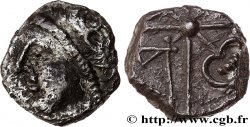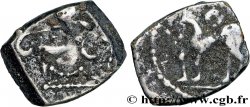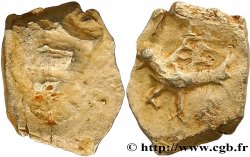bga_196999 - GALLIA - SOUTH WESTERN GAUL - RUTENI (Area of Rodez) Drachme au cheval, “COVRANTILLOS”, fourrée, S. 458
Not available.
Item sold on our e-shop (2009)
Price : 600.00 €
Item sold on our e-shop (2009)
Price : 600.00 €
Type : Drachme au cheval, “COVRANTILLOS”, fourrée, S. 458
Date: IIe-Ier siècles av. J.-C.
Metal : silver
Diameter : 15,5 mm
Orientation dies : 3 h.
Weight : 2,73 g.
Rarity : R3
Coments on the condition:
Monnaie fourrée et taillée au burin. Le droit est presque complet avec une faiblesse de frappe sur la partie supérieure. Le revers est un peu court, mais en très bonne qualité. Fine patine de collection, irisée et brillante
Catalogue references :
Predigree :
Cette drachme est celle qui illustre le Savès, n° 458 ; elle provient du site de Vieille-Toulouse
Obverse
Obverse legend : ANÉPIGRAPHE.
Obverse description : Tête bouclée à droite, l'arcade sourcilière bien marquée ; chevelure bouclée assez basse ; bouche faite de deux traits ; grènetis et semis de perles.
Reverse
Reverse legend : COVRA/ NTILLOS.
Reverse description : Cheval galopant à droite, crinière bouletée, queue à dents de scie, jambes aux articulations bouletées.
Commentary
Ce type particulier avec des perles dans la chevelure et l’oreille marquée est indiqué R4 par G Savès ; cela correspond à un seul exemplaire connu !
La légende COVRA est complète en bord de flan sous le cheval et la légende NTILLOS est presque complète au-dessus du cheval.
Les monnaies à la croix épigraphe sont très recherchées. Pour la légende COVRANTILLOS, seulement 17 exemplaires ont été répertoriés par R. Boudet ; deux en collections privées, deux à la BN, un au musée de Toulouse, trois dans le trésor du Causé et six provenant de Vieille-Toulouse. Les trois restantes étant passés en ventes.
La légende COVRA est complète en bord de flan sous le cheval et la légende NTILLOS est presque complète au-dessus du cheval.
Les monnaies à la croix épigraphe sont très recherchées. Pour la légende COVRANTILLOS, seulement 17 exemplaires ont été répertoriés par R. Boudet ; deux en collections privées, deux à la BN, un au musée de Toulouse, trois dans le trésor du Causé et six provenant de Vieille-Toulouse. Les trois restantes étant passés en ventes.








 Report a mistake
Report a mistake Print the page
Print the page Share my selection
Share my selection Ask a question
Ask a question Consign / sell
Consign / sell
 Full data
Full data



